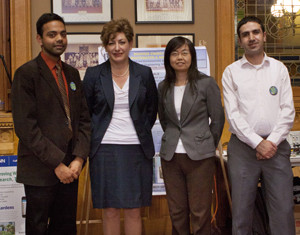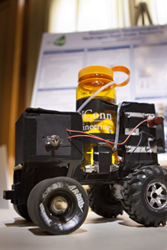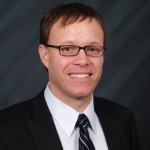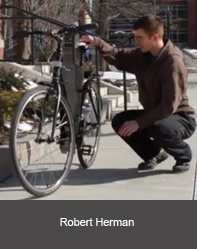Mechanical Engineering Demos Shine at the Capitol
On Thursday, April 11th, a dedicated team of students and faculty demonstrated and discussed innovative “home grown” engineering prototypes at the Connecticut State Capitol during a rally in support of Governor Dannel P . Malloy’s proposed Next Generation Connecticut.
. Malloy’s proposed Next Generation Connecticut.
Next Generation Connecticut is aimed at reenergizing and redefining Connecticut’s economy through strategic investments in science, technology, engineering, and math disciplines (STEM) at UConn. The bill, which is making its way through the legislative process, was passed overwhelmingly by the Finance, Revenue and Bonding Committee on April 16th.
Among the featured speakers were Gov. Malloy, UConn President Susan Herbst, UConn Provost Mun Y. Choi, elected officials, labor and business council leaders, as well as two outspoken executives from Connecticut businesses: Robert Friedland, co-founder, president, and CEO of Wallingford-based Proton OnSite; and Ed Murphy, Senior Director of Technology Planning and Intellectual Property at JDS Uniphase in Bloomfield.
But for many attendees, the most compelling demonstration of why Connecticut should invest in UConn’s STEM programs was evidenced by the array of extraordinary projects designed and developed by UConn students and faculty members. The selection of UConn Engineering projects displayed included a custom test stand for a common surgical implement, a fuel cell-powered model vehicle, unmanned autonomous aerial and land vehicles, a microbial fuel cell, and 3D manufacturing apparatus. The projects and demonstrators are summarized below. See photos here.
Surgical Tool Test Device
For their senior-year design project, Biomedical Engineering students Kathryn Dobler, John Burke and Jordy Schuller designed and built a custom, prototype testing device for a Covidien product, the Premium Surgiclip™, used to clamp off blood vessels during surgery. A hand-held, stapler-like device is used to apply the clip during surgery. The medical equipment giant Covidien tasked the students to develop a fixture capable of performing several different tests to determine the force applied by the clip dispenser and its effect on the clip. The testing unit is integrated within a machine that tests for tensile, compression, fatigue, impact and hardness, with the measures displayed on an attached computer screen. The students explained that the ultimate goal of the project is to establish a clinically acceptable product specification that can be measured and evaluated.
Hydrogen-Powered Fuel Cell Car
 Seniors Nicholas Morse and Leia Dwyer, with their advisor, Dr. William Mustain (Chemical & Biomolecular Engineering) demonstrated “The Chegger,” a model car that runs on a hydrogen-powered fuel cell. The car was developed for an American Institute of Chemical Engineers-sponsored competition, ChemECar. Entries must rely on chemical reactions to power the motor and stop the car. The Chegger employs a light-activated electronic circuit incorporating an iodine chemical reaction to stop the car. For the ChemECar competition, vehicles must travel a fixed distance while carrying a payload, but the distance and weight requirements are not revealed to teams until competition day. Dr. Mustain and his research team are making advances in the area of electrocatalyst materials for energy conversion and storage, and in enhancing our understanding of the fundamental science behind fuel cell technology, that may contribute to the future of fuel cell applications in energy.
Seniors Nicholas Morse and Leia Dwyer, with their advisor, Dr. William Mustain (Chemical & Biomolecular Engineering) demonstrated “The Chegger,” a model car that runs on a hydrogen-powered fuel cell. The car was developed for an American Institute of Chemical Engineers-sponsored competition, ChemECar. Entries must rely on chemical reactions to power the motor and stop the car. The Chegger employs a light-activated electronic circuit incorporating an iodine chemical reaction to stop the car. For the ChemECar competition, vehicles must travel a fixed distance while carrying a payload, but the distance and weight requirements are not revealed to teams until competition day. Dr. Mustain and his research team are making advances in the area of electrocatalyst materials for energy conversion and storage, and in enhancing our understanding of the fundamental science behind fuel cell technology, that may contribute to the future of fuel cell applications in energy.
Autonomous Vehicles [View a video here]
 Mechanical Engineering students Roseanna Warren, Yuqian Liu, Jiaxing Che and Robert Herman, accompanied by their advisor, Dr. Chengyu Cao, showcased prototype autopilots along with quad-copter and helicopter models – unmanned autonomous vehicles designed and constructed in the Adaptive Systems, Intelligence and Mechatronics (AIM) Lab. Dr. Cao’s lab is developing novel control algorithms to enable the vehicles to adapt to local and environmental uncertainties, such as obstacles and varying terrain. The team is also linking the vehicle control systems into networks that allow for more complex interactions among the vehicles. Other focuses include the auto-pilot technology and circuits that host the control and navigation algorithms. The team’s work will improve the robustness and adaptive capabilities of unmanned vehicle networks.
Mechanical Engineering students Roseanna Warren, Yuqian Liu, Jiaxing Che and Robert Herman, accompanied by their advisor, Dr. Chengyu Cao, showcased prototype autopilots along with quad-copter and helicopter models – unmanned autonomous vehicles designed and constructed in the Adaptive Systems, Intelligence and Mechatronics (AIM) Lab. Dr. Cao’s lab is developing novel control algorithms to enable the vehicles to adapt to local and environmental uncertainties, such as obstacles and varying terrain. The team is also linking the vehicle control systems into networks that allow for more complex interactions among the vehicles. Other focuses include the auto-pilot technology and circuits that host the control and navigation algorithms. The team’s work will improve the robustness and adaptive capabilities of unmanned vehicle networks.
Benthic Microbial Fuel Cell (BMFCs)
Graduate students Udayarka Karra (Civil & Environmental Engineering) and Ridvan Umaz (Electrical & Computer Engineering), accompanied by Dr. Baikun Li (Civil & Environmental Engineering), demonstrated two bench-scale microbial fuel cells that generate electricity through the metabolic activity of anaerobic bacteria and the decay of organic matter found in the top layer of sediment in bodies of water. The research team anticipates these devices may provide a steady power supply for remote oceanographic devices used in sensing and monitoring ocean environments. A focus is on developing a distributed network to address the energy supply problems for underwater sensor network applications. Dr. Li and her team are exploring and testing various facets of the technology, including novel electrode materials, BMFC configurations, power management schemes, and microbial ecology analysis to enhance understanding of the various aspects related to underwater bioenergy conversion.
3D Manufacturing
Sonya Renfro, Program Coordinator for Diversity & Outreach, and junior Monica Smith (Mechanical Engineering and German) demonstrated 3D printing using a desktop device in which a three-dimensional object is built layer-by-layer using a plastic material. The device is one of two used by UConn’s Engineering Ambassadors in outreach visits to middle and high school students aimed at exciting the students in engineering as a fun and creative career choice. Often used for rapid-prototyping of highly complex geometries, 3D printing begins with a digital CAD design, which software interprets as a series of thin horizontal slices. The 3D printer then builds the actual shape in successive layers. Inexpensive machines are now being used to produce sculptures, machine parts, jewelry, home furnishings, and medical implants. 3D printing is related to the more complex additive manufacturing technologies underway at UConn’s recently announced Pratt & Whitney Additive Manufacturing Innovation Center, which hosts state-of-the-art Arcam electron beam devices that are suitable for manufacturing large, complex metal parts from a range of different materials at high temperature.
Published: April 24, 2013
 dynamic systems and controls to advance the technology development in advanced manufacturing, mechatronics, robotics, precision engineering, system and optimization, and human-machine interactions. He has worked closely with the precision control and information storage industries, and helped Western Digital Corporation develop multiple new servo designs for industrial mass production. Dr. Chen is a recipient of the Young Investigator Award in 2014 ISCIE / ASME International Symposium on Flexible Automation and the 2012 Chinese Government Award for Outstanding Students. He received his Ph.D. from UC Berkeley in 2010 and 2013, respectively.
dynamic systems and controls to advance the technology development in advanced manufacturing, mechatronics, robotics, precision engineering, system and optimization, and human-machine interactions. He has worked closely with the precision control and information storage industries, and helped Western Digital Corporation develop multiple new servo designs for industrial mass production. Dr. Chen is a recipient of the Young Investigator Award in 2014 ISCIE / ASME International Symposium on Flexible Automation and the 2012 Chinese Government Award for Outstanding Students. He received his Ph.D. from UC Berkeley in 2010 and 2013, respectively. joins the Mechanical Engineering department. His current research interests lie in incorporating localized failure mode criteria (such as stress and fatigue), as well as manufacturing, cost and geometric constraints in topology and shape optimization for the design exploration of structures and materials, with the aim of exploring efficient structures tailored to a specific manufacturing process. Prior to joining our department, he was responsible for the Product Optimization group at Caterpillar, where he and his team researched numerical methods and developed computational tools for structural and multidisciplinary optimization. He earned his Ph.D from the University of Illinois at Urbana-Champaign in 2005.
joins the Mechanical Engineering department. His current research interests lie in incorporating localized failure mode criteria (such as stress and fatigue), as well as manufacturing, cost and geometric constraints in topology and shape optimization for the design exploration of structures and materials, with the aim of exploring efficient structures tailored to a specific manufacturing process. Prior to joining our department, he was responsible for the Product Optimization group at Caterpillar, where he and his team researched numerical methods and developed computational tools for structural and multidisciplinary optimization. He earned his Ph.D from the University of Illinois at Urbana-Champaign in 2005. micro-assembly approaches, magnetics, microfluidics, cell and tissue mechanics, regenerative medicine, cryopreservation, and cell-based diagnostics for point-of-care. Dr. Tasoglu’s achievements in research and teaching have been recognized by fellowships and awards including Chang-Lin Tien Fellowship in Mechanical Engineering, Allen D. Wilson Memorial Scholarship, and UC Berkeley Institute Fellowship for Preparing Future Faculty. His work has been featured as the cover of Advanced Materials, Small, Trends in Biotechnology, and Physics of Fluids and highlighted in Nature Medicine, Boston Globe, Reuters Health, and Boston Magazine. He received his Ph.D. in 2011 from UC Berkeley.
micro-assembly approaches, magnetics, microfluidics, cell and tissue mechanics, regenerative medicine, cryopreservation, and cell-based diagnostics for point-of-care. Dr. Tasoglu’s achievements in research and teaching have been recognized by fellowships and awards including Chang-Lin Tien Fellowship in Mechanical Engineering, Allen D. Wilson Memorial Scholarship, and UC Berkeley Institute Fellowship for Preparing Future Faculty. His work has been featured as the cover of Advanced Materials, Small, Trends in Biotechnology, and Physics of Fluids and highlighted in Nature Medicine, Boston Globe, Reuters Health, and Boston Magazine. He received his Ph.D. in 2011 from UC Berkeley. 
 The four-day competition brings together teams of university undergraduate and graduate students from around the world to conceive, design, fabricate and compete with a small, formula style, competition vehicle. To give teams the maximum design flexibility and the freedom to express their creativity and imagination, there are very few restrictions on the overall vehicle design. Teams typically spend eight to twelve months designing, building and preparing their vehicles before a competition.
The four-day competition brings together teams of university undergraduate and graduate students from around the world to conceive, design, fabricate and compete with a small, formula style, competition vehicle. To give teams the maximum design flexibility and the freedom to express their creativity and imagination, there are very few restrictions on the overall vehicle design. Teams typically spend eight to twelve months designing, building and preparing their vehicles before a competition. Dr. Barber has served as a professor-in-residence in the Mechanical Engineering Department since joining UConn in 2000. He enjoyed a distinguished career with Pratt & Whitney and the United Technologies Research Center prior to joining UConn. Dr. Barber is an Associate Fellow of AIAA and a member of ASME, and he has served as an Associate Editor of the AIAA Journal for Propulsion and Power. His induction into CASE recognizes his contributions to computational fluid mechanics, his leadership in expanding and managing the professional Master of Engineering (MENG) degree program and oversight and expansion of the Mechanical Engineering senior design program.
Dr. Barber has served as a professor-in-residence in the Mechanical Engineering Department since joining UConn in 2000. He enjoyed a distinguished career with Pratt & Whitney and the United Technologies Research Center prior to joining UConn. Dr. Barber is an Associate Fellow of AIAA and a member of ASME, and he has served as an Associate Editor of the AIAA Journal for Propulsion and Power. His induction into CASE recognizes his contributions to computational fluid mechanics, his leadership in expanding and managing the professional Master of Engineering (MENG) degree program and oversight and expansion of the Mechanical Engineering senior design program. to understanding micro- and nano-structure induced transport phenomena in energy, photonics and semiconductor materials. Dr. Chiu’s honors include the Rutgers University School of Engineering Medal of Excellence Award for Distinguished Young Alumni, the ASME Bergles-Rohsenow Young Investigator Award in Heat Transfer, the U.S. Army Research Office Young Investigator Award, a National Science Foundation CAREER Award and the Office of Naval Research Young Investigator Award. He is an Associate Editor of the ASME Journal of Heat Transfer and the International Journal of Thermal Sciences.
to understanding micro- and nano-structure induced transport phenomena in energy, photonics and semiconductor materials. Dr. Chiu’s honors include the Rutgers University School of Engineering Medal of Excellence Award for Distinguished Young Alumni, the ASME Bergles-Rohsenow Young Investigator Award in Heat Transfer, the U.S. Army Research Office Young Investigator Award, a National Science Foundation CAREER Award and the Office of Naval Research Young Investigator Award. He is an Associate Editor of the ASME Journal of Heat Transfer and the International Journal of Thermal Sciences. UConn Engineering was well represented during the Second Annual Celebration of Innovation, presented by the UConn Office of Economic Development on April 10th. The gala event (see event photos
UConn Engineering was well represented during the Second Annual Celebration of Innovation, presented by the UConn Office of Economic Development on April 10th. The gala event (see event photos  D.E. Crow Innovation Prize at UConn, which helps engineering students turn their entrepreneurial inspirations into marketable products through seed funding. Dr. Crow joined Pratt & Whitney in 1966 and rose to the position of Senior Vice President of the company’s Engineering, where he oversaw 6,600 engineers responsible for the design, development, validation and certification of all Pratt & Whitney large commercial engines, military engines and rocket products. Earlier, he se
D.E. Crow Innovation Prize at UConn, which helps engineering students turn their entrepreneurial inspirations into marketable products through seed funding. Dr. Crow joined Pratt & Whitney in 1966 and rose to the position of Senior Vice President of the company’s Engineering, where he oversaw 6,600 engineers responsible for the design, development, validation and certification of all Pratt & Whitney large commercial engines, military engines and rocket products. Earlier, he se . Malloy’s proposed Next Generation Connecticut.
. Malloy’s proposed Next Generation Connecticut. Seniors Nicholas Morse and Leia Dwyer, with their advisor, Dr. William Mustain (Chemical & Biomolecular Engineering) demonstrated “The Chegger,” a model car that runs on a hydrogen-powered fuel cell. The car was developed for an American Institute of Chemical Engineers-sponsored competition, ChemECar. Entries must rely on chemical reactions to power the motor and stop the car. The Chegger employs a light-activated electronic circuit incorporating an iodine chemical reaction to stop the car. For the ChemECar competition, vehicles must travel a fixed distance while carrying a payload, but the distance and weight requirements are not revealed to teams until competition day. Dr. Mustain and his research team are making advances in the area of electrocatalyst materials for energy conversion and storage, and in enhancing our understanding of the fundamental science behind fuel cell technology, that may contribute to the future of fuel cell applications in energy.
Seniors Nicholas Morse and Leia Dwyer, with their advisor, Dr. William Mustain (Chemical & Biomolecular Engineering) demonstrated “The Chegger,” a model car that runs on a hydrogen-powered fuel cell. The car was developed for an American Institute of Chemical Engineers-sponsored competition, ChemECar. Entries must rely on chemical reactions to power the motor and stop the car. The Chegger employs a light-activated electronic circuit incorporating an iodine chemical reaction to stop the car. For the ChemECar competition, vehicles must travel a fixed distance while carrying a payload, but the distance and weight requirements are not revealed to teams until competition day. Dr. Mustain and his research team are making advances in the area of electrocatalyst materials for energy conversion and storage, and in enhancing our understanding of the fundamental science behind fuel cell technology, that may contribute to the future of fuel cell applications in energy. Mechanical Engineering students Roseanna Warren, Yuqian Liu, Jiaxing Che and Robert Herman, accompanied by their advisor, Dr. Chengyu Cao, showcased prototype autopilots along with quad-copter and helicopter models – unmanned autonomous vehicles designed and constructed in the Adaptive Systems, Intelligence and Mechatronics (AIM) Lab. Dr. Cao’s lab is developing novel control algorithms to enable the vehicles to adapt to local and environmental uncertainties, such as obstacles and varying terrain. The team is also linking the vehicle control systems into networks that allow for more complex interactions among the vehicles. Other focuses include the auto-pilot technology and circuits that host the control and navigation algorithms. The team’s work will improve the robustness and adaptive capabilities of unmanned vehicle networks.
Mechanical Engineering students Roseanna Warren, Yuqian Liu, Jiaxing Che and Robert Herman, accompanied by their advisor, Dr. Chengyu Cao, showcased prototype autopilots along with quad-copter and helicopter models – unmanned autonomous vehicles designed and constructed in the Adaptive Systems, Intelligence and Mechatronics (AIM) Lab. Dr. Cao’s lab is developing novel control algorithms to enable the vehicles to adapt to local and environmental uncertainties, such as obstacles and varying terrain. The team is also linking the vehicle control systems into networks that allow for more complex interactions among the vehicles. Other focuses include the auto-pilot technology and circuits that host the control and navigation algorithms. The team’s work will improve the robustness and adaptive capabilities of unmanned vehicle networks. She returned to UConn for what would have been her senior year and began studying mechanical engineering. Monica didn’t completely leave Germany behind, though – she currently lives in McMahon Hall as an active member and resident assistant of the Eurotech learning community.
She returned to UConn for what would have been her senior year and began studying mechanical engineering. Monica didn’t completely leave Germany behind, though – she currently lives in McMahon Hall as an active member and resident assistant of the Eurotech learning community. “I was tired of pedaling all the time. Initially, I thought about a scooter, but parental pressure nixed that idea. I ultimately decided to retrofit my bike, a Trek 7.2 FX.”
“I was tired of pedaling all the time. Initially, I thought about a scooter, but parental pressure nixed that idea. I ultimately decided to retrofit my bike, a Trek 7.2 FX.”